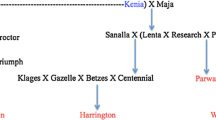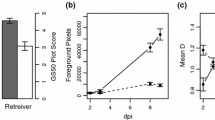Summary
The latent period of barley leafrust, Puccinia hordei, was studied in a number of cultivars at different development stages and growing conditions. The relative latent period of the different cultivars was not affected by temperature. Other environmental factors, like daylength and light-intensity did not seem to have any effect either. The development stage of the plant and the genotype on the other hand influenced the latent period greatly. The latent period became longer for all cultivars tested from the seedling stage onward until a maximum was reached with the young flag leaf at heading. For the most susceptible cultivar, L94, the relative latent period increased from the primary leaf in the seedling stage, set at 100%, to 117 in the young flag leaf. With the fairly resistant cultivar Vada the relative latent period increased from 123 to 233. The genotypic differences in latent period are very much greater in the adult plants stage than in the seedling stage. This and the fact that the relative latent period of the seedling does not predict the relative latent period of the adult plant very well, necessitates a cautious approach of seedling data.
Similar content being viewed by others
References
Caldwell, R. M., 1968. Breeding for general and or specific plant disease resistance. 3rd Proc. Int. Wheat Genet. Symp.: 207–216.
Chamberlain, N. H. & J. K. Doodson, 1972. Brown rust of barley. Agriculture, Lond. 79: 302–305.
Chamberlain, N. H., J. K. Doodson & M. H. Meadway, 1972. A technique for the evaluation of the resistance of barley varieties to infection with brown rust (Puccinia hordei Otth.). J. natn. Inst. agric. Bot. 12: 440–446.
Clifford, B. C., 1972. The histology of race non-specific resistance to Puccinia hordei Otth. in barley. Proc. Eur. and Medit. Cereal Rusts Conf., Prague, I: 75–78.
Farrer, W., 1898. The making and improvement of wheats for Australian conditions. Agr. Gaz. N.S. Wales 9: 131–168.
Luke, H. H., W. H. Chapman & R. D. Barnett, 1972. Horizontal resistance of red rust proof oats to Crown rust. Phytopath. 62: 414–417.
Mehta, Y. R. & J. C. Zadoks, 1970. Uredospore production and sporulation period of Puccinia recondita f. sp. triticina on primary leaves of wheat. Neth. J. Pl. Path. 76: 267–276.
Moseman, J. G., 1969. Studies of inheritance of resistance in barley to pathogenic organisms, 1963–1969. Barley Genetics II, 1969: 535.
Plank, J. E. van der, 1963. Plant diseases: Epidemics and control. Academic press, NY and London. 349 pp.
Plank, J. E. van der 1968. Disease resistance in plants. Academic press, NY and London. 206 pp.
Schaper, S., 1951. Die Bedeuting der Incubationszeit für die Züchtung Krautfäuleresistenter Kartoffelsorten. Z. PflZüchtung 30: 292–299.
Yarwood, C. E., 1961. Uredospore production by Uromyces phaseoli. Phytopathology 51: 22–27.
Zaag, D. E. van der, 1959. Some observations on breeding for resistance to Phytophthora infestans. Eur. Pot. J. 2: 278–286.
Zadoks, J. C., 1972. Modern concepts of disease resistance in cereals. Proc. 6th Congress. Eucarpia, Cambridge: 89–98.
Author information
Authors and Affiliations
Rights and permissions
About this article
Cite this article
Parlevliet, J.E. Partial resistance of barley to leafrust, Puccinia hordei. I. Effect of cultivar and development stage on latent period. Euphytica 24, 21–27 (1975). https://doi.org/10.1007/BF00147164
Received:
Issue Date:
DOI: https://doi.org/10.1007/BF00147164




